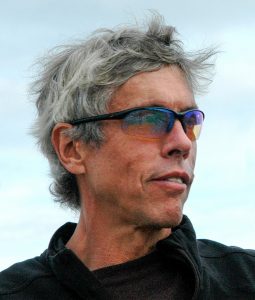Jenkins, Steve
 Steve Jenkins and the Science of Art
Steve Jenkins and the Science of Art
There seems to be a sort of inevitability to some people’s careers. Author and artist Steve Jenkins grew up in a family where science was valued and celebrated. His father eventually taught physics and astronomy and young Steve thought seriously about becoming a scientist as well. Then Art happened.
Steve chose to study graphic design instead of science. The inevitability of his taking his artistic talent and applying that to the animal world, the solar system, a veritable plethora of scientific subjects now seems obvious. “There are some similarities,” says Steve. “Science, in its creative expression, relies on intuitive leaps.” He notes that the same is true of design. “You rely on what you know will work to arrive at a good answer, but great solutions are the result of intuition.”
His father created an environment for making discoveries. Without pushing books, he made sure that books and other tools of intellectual pursuit were available. “Books would just turn up at home though I did not realize it at the time,” recalls the author. “There would be books about dinosaurs, geology or microscopes, or a chemistry set would suddenly appear, ready to be used.”
It was when Steve and his co-author and wife started a family that he saw the possibilities of creating children’s books himself. He and Robin read to the children well into their tween and even into the teen years, so many of their books have sprung from the questions their children had about the natural world. As a side note, Steve recommends reading picture books to kids at all levels as well. He recounts a wise advanced calculus teacher who read a picture book to his daughter’s class once each week.
Steve began working with Robin long before children’s books. They started a design office 30 years ago in New York. It was natural to start working together on the books and Steve notes that he prefers those books, “the back and forth makes it better.” They share an office/studio and sit about eight feet apart. Robin does the preliminary sketching, the layouts, attitude and scale while Steve does the final illustrations and text.
Steve constantly keeps his audience in mind. In spite of an early interest in science, Steve is not a scientist but he finds that this helps him keep the jargon out of the text. “I don’t have the technical background but that can also be a gift because it helps me to convey the ideas in simple terms.”
At the same time, the artist is drawn to things that are particularly suitable for being drawn. “Part of the reason I did a book about beetles is because they lend themselves so well to the medium–they have hard edges and interesting patterns.” A quick glance at The Beetle Book confirms the definition of the colors and the elaborate symmetry of their forms. Steve also has a fondness for frogs for the same reasons, as the reader can witness in The Mystery of Darwin’s Frog. “Sometimes I’m surprised I can’t get a particular animal,” muses the artist. “There’s always a bit of an element of surprise with the illustration.”
The newest Steve Jenkins production is the gloriously exhaustive The Animal Book: A Collection of the Fastest, Fiercest, Toughest, Cleverest, Shyest–and Most Surprising Animals on Earth. The idea for the book actually came from Houghton Mifflin Harcourt where the idea for a bind up of several of his earlier works was proposed. Upon further examination, the idea was unworkable as it was. “The formats and reading levels were too different not to mention weird gaps and overlaps.” He liked the idea of a more expansive book, however, “so I proposed that I create an editorial context.” The result has already captured five starred reviews (at press time) and an untold number of new fans to Jenkins’ distinctive illustration style and voice.
One of his most popular works is Actual Size. While his illustrations are limited to the dimensions of a book, teachers have found it a spectacular springboard to explore the animal world. Proud teachers and their students have sent the author pictures of their projects which have included representations of a full-sized elephant on a floor, a reticulated python and a giant squid stretching down a school corridor.
The success of What Do You Do With A Tail Like This? is a direct result of the Caldecott Honor in 2004. Steve had no idea that the awards were being discussed that weekend. “I’m not sure I appreciated how significant it was in terms of a career–all of that unfolded for me later.”
The author has always kept notes on ideas he would like to pursue. Because of his past successes, Steve Jenkins can continue to explore “the intersection of physics, astronomy, and animals” in a way that is both meaningful to the mind and bewitching to behold.
Learn more at Steve Jenkins’ website.
– Interviewed by Ellen Myrick in December 2013
Click here for titles available in the BTSB Bookstore from this author
